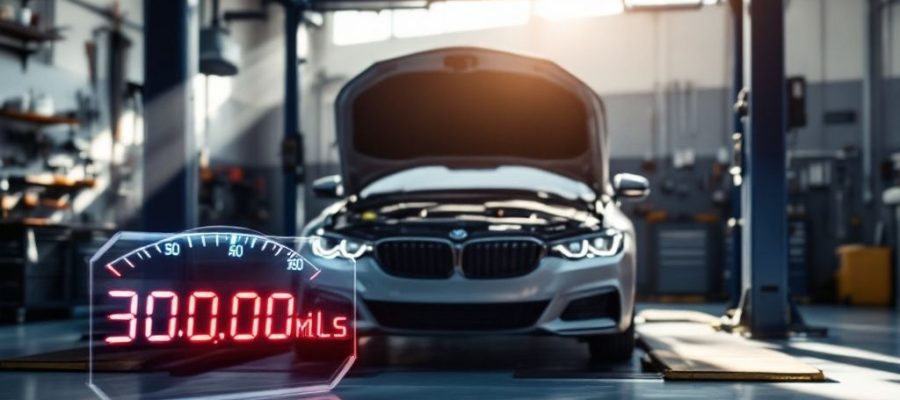
Following a car maintenance schedule by mileage keeps your car running smoothly and prevents costly repairs. This listicle provides a clear guide to eight essential maintenance tasks, from oil changes and tire rotations to brake inspections and transmission service. Knowing what your car needs at specific mileage intervals ensures a safe, reliable ride and maximizes your car’s lifespan. This concise car maintenance schedule by mileage helps you stay organized and proactive. Kwik Kar of Mesquite, your local auto repair experts, can assist with all your car maintenance needs. Visit us at 2122 N Belt Line Rd, Mesquite, TX or check our website.
One of the most critical maintenance tasks in any car maintenance schedule by mileage is the oil and filter change. This involves draining the old, contaminated engine oil and replacing it with fresh oil, along with a new oil filter. This process is vital because engine oil performs several crucial functions: it lubricates moving parts within the engine, reducing friction and wear; it helps cool the engine by absorbing heat; and it cleans the engine by carrying away dirt and debris. Regular oil changes are essential to prevent premature engine wear and extend the life of your vehicle.
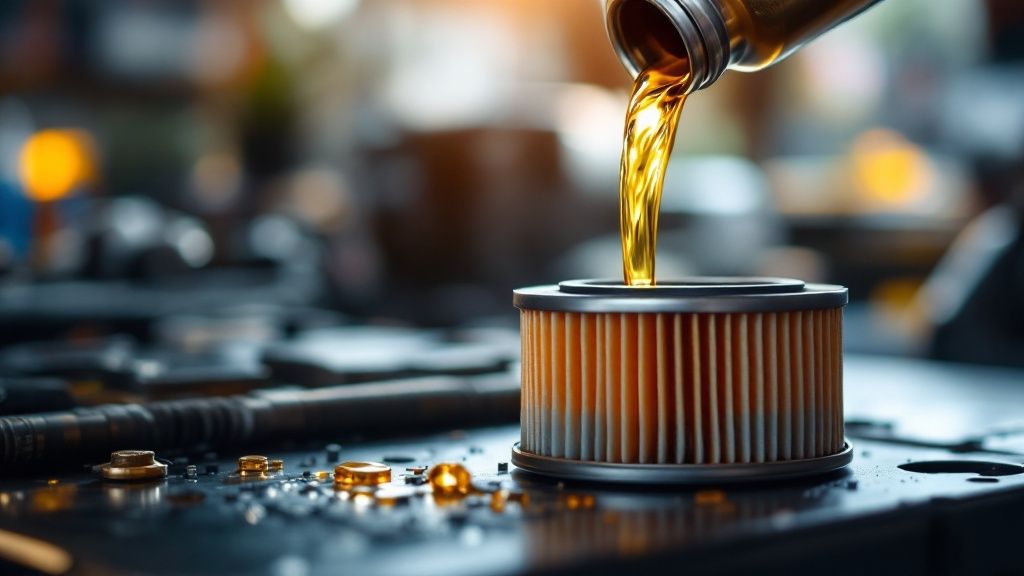
Oil changes are typically recommended every 3,000 to 10,000 miles, depending on the vehicle, driving conditions, and the type of oil used. Synthetic oils generally last longer than conventional oils, offering better performance and protection in demanding conditions. The oil change process includes replacing both the oil and the oil filter, as a clogged filter can restrict oil flow and compromise engine performance. Regularly checking your oil level and quality between changes is also important to ensure your engine is adequately lubricated. This simple check can prevent significant engine damage down the road. This makes it a top priority in any car maintenance schedule by mileage, particularly for those in demanding professions like our local Mesquite commuters, military personnel, first responders, healthcare workers, and busy professionals who rely on their vehicles daily. Even families with young children who value on-site amenities will appreciate the convenience and peace of mind that comes with regular maintenance.
Features and Benefits:
Pros and Cons:
Examples of Successful Implementation:
Actionable Tips:
Learn more about Oil and Filter Change
This vital maintenance task deserves its place at the top of the car maintenance schedule by mileage list because it is fundamental to engine health and longevity. Ignoring oil changes can lead to catastrophic engine failure, a far more expensive problem than regular maintenance. By adhering to a consistent oil change schedule, drivers can ensure optimal engine performance, improve fuel efficiency, and avoid costly repairs. This is particularly important for our target audience – from small business owners and fleet managers needing reliable vehicles to busy professionals needing efficient commutes – keeping their vehicles running smoothly is paramount.
Maintaining proper tire pressure and rotating your tires regularly are crucial components of any car maintenance schedule by mileage. Tire rotation involves moving tires from one position to another on your vehicle, ensuring even wear distribution across all four. This, combined with maintaining the correct tire pressure, maximizes tire lifespan, improves fuel efficiency, enhances handling, and promotes safer driving conditions. This is essential for everyone from daily commuters in Mesquite to first responders and families with young children who prioritize safety.
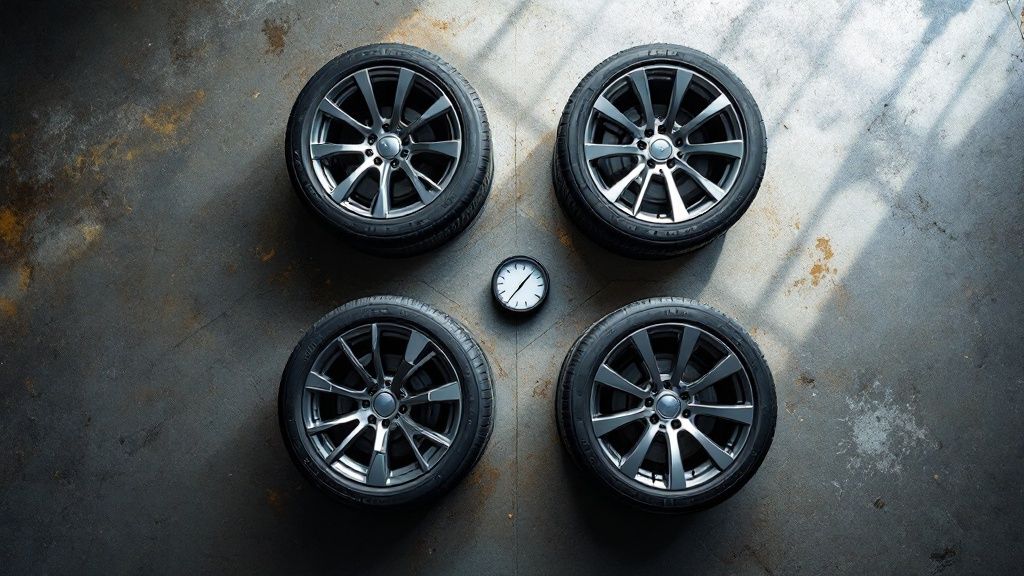
Tire rotation is typically recommended every 5,000-8,000 miles as part of your car maintenance schedule by mileage. The exact mileage may vary based on your vehicle’s make and model, driving conditions, and tire type. Consult your owner’s manual for specific recommendations. Different rotation patterns exist depending on whether your vehicle is front-wheel drive (FWD), rear-wheel drive (RWD), or all-wheel drive (AWD). This process often includes checking tread depth and overall tire condition for signs of wear and tear or damage. For optimal performance, tire rotation is frequently paired with tire balancing.
Features and Benefits:
Pros:
Cons:
Examples:
Actionable Tips:
Tire manufacturers like Michelin, Bridgestone, and Goodyear all emphasize the importance of tire rotation and pressure checks as part of a regular car maintenance schedule by mileage. Discount Tire even offers free rotation for customers who purchase tires from them, highlighting the value of this service. By adhering to a regular tire rotation and pressure check schedule, you are investing in the longevity of your tires, the safety of your vehicle, and your peace of mind on the road.
Maintaining a regular car maintenance schedule by mileage is crucial for vehicle safety and longevity, and a key part of that schedule is brake system inspection and service. This critical system is responsible for stopping your vehicle safely and efficiently, making its upkeep a top priority for all drivers, especially local Mesquite commuters, military personnel, first responders, healthcare workers, and families with young children.
Brake system maintenance involves inspecting and servicing all components that contribute to stopping power, including brake pads, rotors, calipers, brake fluid, and lines. These components work together to convert kinetic energy into heat, effectively slowing or stopping your vehicle. When you press the brake pedal, it activates the master cylinder, which pressurizes brake fluid and transmits force through the brake lines to the calipers. The calipers then squeeze the brake pads against the rotors, creating friction and slowing the wheels.
Features and Benefits of Regular Brake Service:
Pros:
Cons:
Actionable Tips:
Companies like Brembo, known for high-performance brake systems, Akebono, a pioneer in ceramic brake technology, Bosch, a leading manufacturer of brake components, and Midas, popular for brake service packages, all contribute to the innovation and accessibility of brake system technology.
Learn more about Brake System Inspection and Service
This item is crucial in any car maintenance schedule by mileage because neglecting your brake system can have severe consequences. For busy professionals, students, small business owners, and fleet managers in Mesquite, regular brake maintenance ensures reliable and safe transportation, minimizing downtime and maximizing productivity. For families and individuals, it provides the peace of mind that comes with knowing your vehicle can stop safely and effectively in any situation. Therefore, incorporating regular brake system inspections and service into your car maintenance schedule by mileage is an investment in safety and long-term vehicle health.
As part of a comprehensive car maintenance schedule by mileage, regular air filter replacement is crucial for both engine performance and passenger health. This involves changing two key filters: the engine air filter and the cabin air filter. Neglecting these filters can impact fuel efficiency, engine longevity, and the air quality inside your vehicle. This is especially important for Mesquite commuters, military personnel, first responders, healthcare workers, families, and anyone prioritizing a healthy and efficient vehicle.
How Air Filters Work:
The engine air filter acts as the lungs of your car. It sits between the outside air and the engine intake, trapping dust, dirt, pollen, and other debris that could damage internal engine components. A clean engine air filter ensures the correct air-fuel mixture for optimal combustion and performance. The cabin air filter, on the other hand, cleans the air that circulates inside the vehicle’s HVAC system. It removes pollutants, allergens, and unpleasant odors, creating a more comfortable and healthy environment for passengers, which is particularly beneficial for families with young children and those sensitive to allergens.
When to Replace Air Filters:
A simple visual inspection can help determine if a filter needs changing sooner. Hold the filter up to a light source. If light doesn’t pass through easily, it’s time for a new one.
Benefits of Air Filter Replacement:
Pros and Cons:
Actionable Tips:
Why Air Filter Replacement Deserves Its Place in Your Car Maintenance Schedule by Mileage:
Regular air filter replacement is a simple yet vital part of car maintenance. It offers significant benefits in terms of engine performance, fuel efficiency, and passenger comfort. By incorporating this task into your car maintenance schedule by mileage, you can ensure your vehicle runs smoothly, efficiently, and provides a healthy environment for you and your passengers. This is especially crucial for busy professionals, students, and anyone relying on a dependable vehicle.
As part of your car maintenance schedule by mileage, a coolant system flush and refill is crucial for maintaining the health and longevity of your engine. This process involves draining the old antifreeze/coolant, cleaning the cooling system to remove built-up deposits and contaminants, and then refilling it with fresh coolant. This service is vital for preventing corrosion, ensuring proper operating temperatures, and ultimately protecting your engine from overheating and potential damage. It’s a key element of preventative maintenance that can save you from costly repairs down the line.
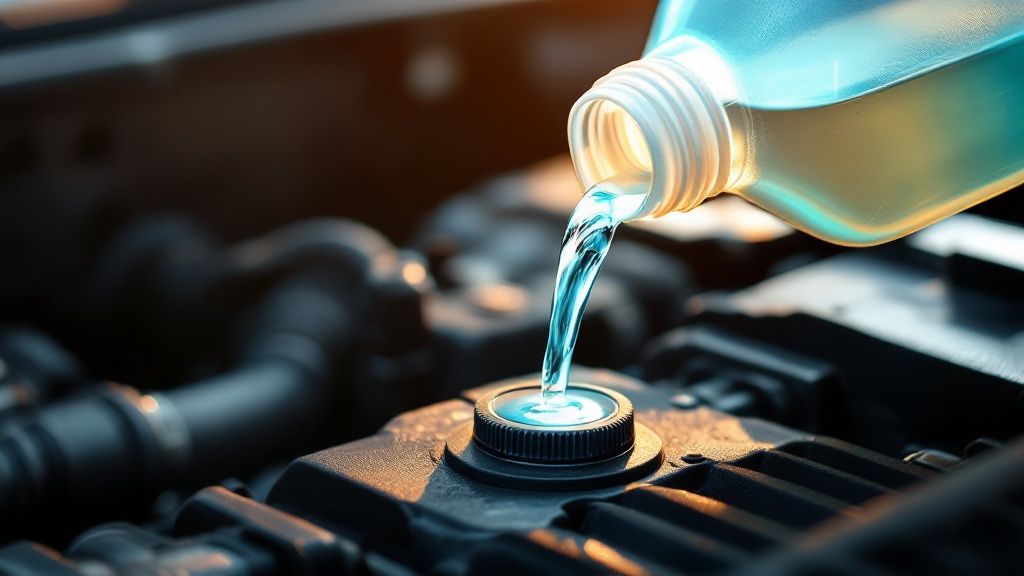
A coolant flush is typically recommended every 30,000 to 60,000 miles as part of a comprehensive car maintenance schedule by mileage. However, this can vary depending on your vehicle manufacturer’s recommendations and the type of coolant used. Some modern long-life coolants, like the red Toyota Super Long Life Coolant, are designed to last for 100,000 miles or more before the first replacement. For example, many Ford models using their orange coolant recommend changes every 50,000 miles. It’s always best to consult your owner’s manual for specific intervals.
This service isn’t just about replacing the fluid; it’s a crucial opportunity for inspection. A proper coolant system flush includes a thorough inspection of critical components, such as hoses, the radiator, the water pump, and the thermostat. These parts are vital for regulating engine temperature and are susceptible to wear and tear. Identifying potential problems early can prevent more significant issues, like leaks or component failures, that can lead to overheating and engine damage.
Pros:
Cons:
Tips for Coolant System Maintenance:
Popular coolant brands like Prestone, Zerex, Peak, and Valvoline offer a variety of products and services to help you maintain your cooling system. For busy professionals, commuters, families, and first responders in Mesquite, adhering to a proper car maintenance schedule by mileage, including regular coolant system flushes, is vital for ensuring reliable transportation and preventing costly breakdowns. This is especially true for those who rely on their vehicles for work, emergencies, or family needs. A well-maintained cooling system is a crucial investment in the longevity and performance of your vehicle.
Transmission service is a crucial part of any car maintenance schedule by mileage and significantly impacts your vehicle’s performance and longevity. This service encompasses several procedures aimed at keeping your transmission in optimal condition, including changing or flushing the transmission fluid, replacing the filter (if applicable), and inspecting the overall system for any signs of wear or damage. This maintenance is particularly important because the transmission is one of the most complex and expensive components in your vehicle. Neglecting its care can lead to costly repairs down the line.
Your transmission facilitates the transfer of power from your engine to the wheels, allowing your car to shift gears and operate smoothly. Over time, transmission fluid degrades, losing its lubricating properties and accumulating debris. This degradation can negatively affect shift quality, reduce fuel efficiency, and ultimately shorten the lifespan of your transmission. Regular servicing combats these issues.
Features of Transmission Service:
Pros of Regular Transmission Service:
Cons of Transmission Service:
Examples of Specific Transmission Service Intervals:
Actionable Tips for Transmission Maintenance:
For local Mesquite commuters and daily drivers, military personnel, first responders, healthcare workers, families, busy professionals, students, small business owners, and fleet managers alike, adhering to a proper car maintenance schedule by mileage, including regular transmission service, is essential for ensuring vehicle reliability, performance, and longevity. This proactive approach can minimize downtime and save money on costly repairs in the long run. This item deserves its place on this list because the transmission is a critical and expensive component. Proactive maintenance protects this investment. Companies like AAMCO, Valvoline (with their MaxLife transmission fluid), ZF, and Aisin all highlight the importance of transmission maintenance, further solidifying its significance in a comprehensive car maintenance schedule.
Spark plug replacement is a crucial part of any car maintenance schedule by mileage. It involves removing the old spark plugs and installing new ones. Spark plugs ignite the compressed air-fuel mixture within your engine’s cylinders, initiating combustion. This controlled explosion drives the pistons, ultimately powering your vehicle. Maintaining healthy spark plugs ensures efficient combustion, leading to better fuel economy, smoother engine operation, and reliable starting.
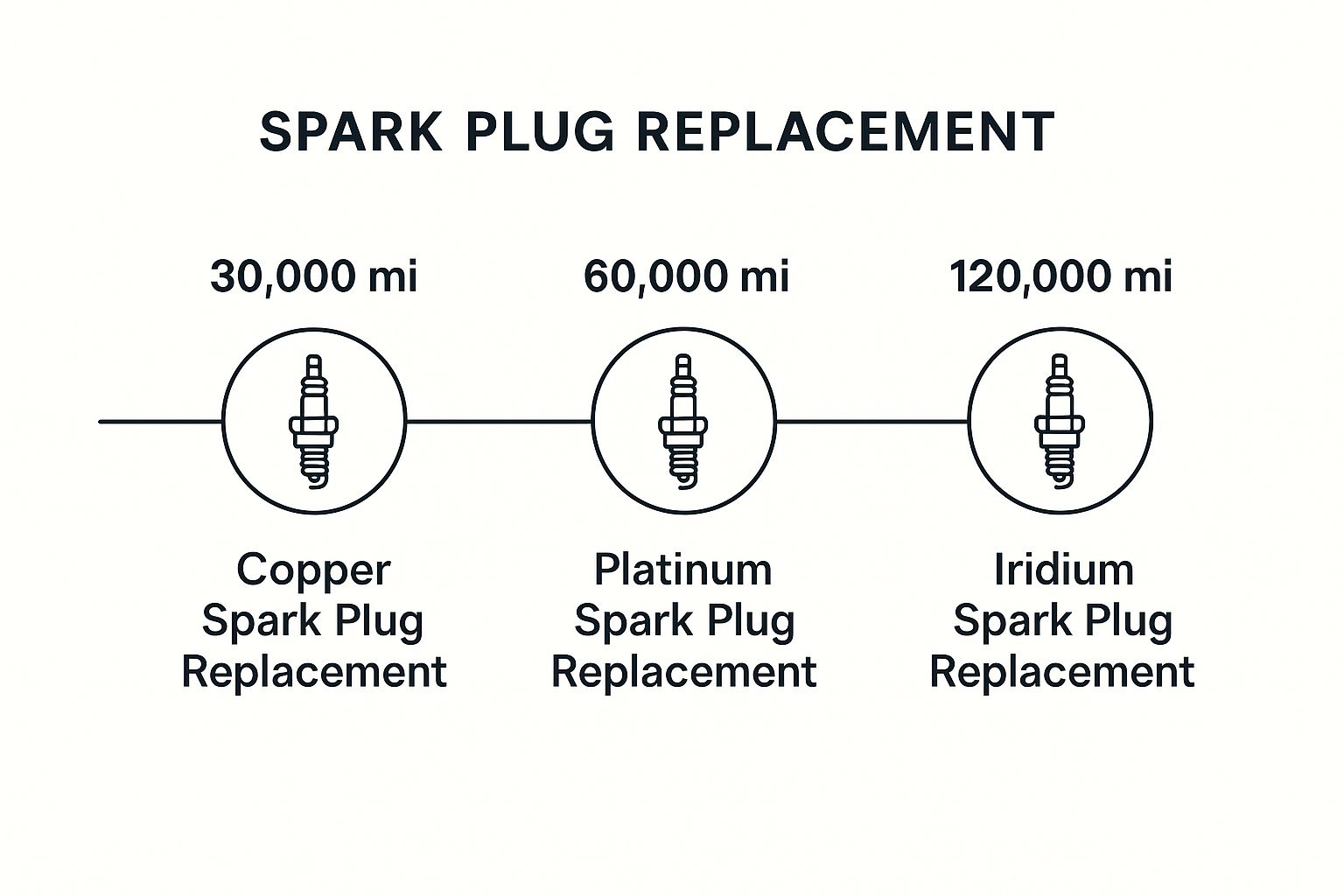
The infographic above visualizes the typical lifespan of different spark plug types and when they should be replaced as part of your car maintenance schedule by mileage. It highlights the longevity of iridium and platinum spark plugs compared to traditional copper plugs, demonstrating the cost-effectiveness of these long-life options over time.
As visualized in the timeline, traditional copper spark plugs typically require replacement every 30,000-40,000 miles. This makes them a more frequent maintenance item for those adhering to a strict car maintenance schedule by mileage. However, advancements in spark plug technology have led to the development of long-life platinum and iridium spark plugs, which can last anywhere from 60,000 to 120,000 miles, significantly reducing the frequency of this maintenance task. This is a significant benefit for busy professionals, families, and fleet managers in Mesquite who need to minimize vehicle downtime. For our military personnel, first responders, and healthcare workers, reliable transportation is paramount, and long-life spark plugs contribute significantly to vehicle dependability.
Examples of Successful Implementation:
Pros:
Cons:
Actionable Tips for Spark Plug Replacement:
Popularized by Industry Leaders:
Companies like NGK, Bosch, Denso, and Champion have played significant roles in advancing spark plug technology, offering reliable and high-performance options for various vehicle makes and models.
Spark plug replacement earns its spot in the car maintenance schedule by mileage due to its direct impact on engine performance, fuel efficiency, and reliability. By following the recommended intervals and utilizing quality spark plugs, drivers can ensure their vehicles run smoothly and efficiently for years to come. This is especially important for our target audience in Mesquite, from daily commuters to busy professionals, who rely on their vehicles for work, family, and everyday life.
Maintaining a reliable vehicle requires adhering to a car maintenance schedule by mileage, and a crucial part of this schedule is regular belt and hose inspection and replacement. This service focuses on the drive belts (serpentine, timing) and various hoses (coolant, vacuum, fuel) within your engine. These components are vital for transferring power between engine parts and transporting essential fluids throughout your vehicle. Neglecting their maintenance can lead to breakdowns, costly repairs, and even extensive engine damage.
How it Works:
Drive belts, like the serpentine belt, power essential accessories such as the alternator, power steering pump, and air conditioning compressor. The timing belt (or chain in some vehicles) is critical for synchronizing the engine’s valves and pistons. Hoses transport fluids like coolant, fuel, and vacuum to different parts of the engine and related systems. Over time, these components wear down due to heat, friction, and exposure to chemicals. Regular inspections and timely replacements are essential to prevent failures.
Why This Matters in Your Car Maintenance Schedule by Mileage:
Belt and hose failures can have serious consequences. A broken serpentine belt can disable your power steering, alternator, and air conditioning. A snapped timing belt can lead to catastrophic engine damage, requiring costly repairs or even engine replacement. Leaky hoses can cause overheating, fuel leaks, and other problems. Incorporating belt and hose maintenance into your car maintenance schedule by mileage helps avoid these issues and keeps your vehicle running smoothly.
Features and Benefits:
Pros:
Cons:
Examples:
Actionable Tips for Mesquite Commuters, Military Personnel, Families, and Busy Professionals:
This maintenance item is crucial for everyone from Mesquite commuters facing stop-and-go traffic and extreme temperatures, to military personnel, first responders, and healthcare workers who need reliable transportation, to families with young children and busy professionals who can’t afford unexpected breakdowns. By following the recommended car maintenance schedule by mileage, you can avoid costly repairs and ensure your vehicle remains dependable.
| Maintenance Task | Implementation Complexity 🔄 | Resource Requirements ⚡ | Expected Outcomes 📊 | Ideal Use Cases 💡 | Key Advantages ⭐ |
|---|---|---|---|---|---|
| Oil and Filter Change | Moderate; requires draining and replacing oil/filter | Basic tools and quality oil/filter | Longer engine life, improved fuel efficiency | Routine engine upkeep, regular interval maintenance | High effectiveness, cost-efficient, DIY-friendly |
| Tire Rotation and Pressure Check | Low; simple tire repositioning and pressure check | Basic tools, tire pressure gauge | Even tire wear, better handling and safety | Regular tire maintenance, before long trips | Extends tire life, improves safety and fuel economy |
| Brake System Inspection and Service | Moderate to high; involves inspection and parts replacement | Specialized tools and brake components | Enhanced safety, consistent braking | Safety-critical maintenance, noise or performance issues | Crucial for safety, prevents costly repairs |
| Air Filter Replacement | Low; straightforward filter swap | Replacement filters, minimal tools | Improved fuel efficiency, cleaner cabin air | Routine air quality and engine performance upkeep | Easy DIY task, inexpensive, improves comfort |
| Coolant System Flush and Refill | Moderate; draining, flushing, refilling coolant | Coolant fluid, disposal tools, inspection | Prevents overheating and corrosion | Periodic cooling system maintenance | Protects engine, extends cooling system life |
| Transmission Service | High; fluid change/flush, filter replacement | Specialized fluids, tools, expertise | Longer transmission life, smoother shifting | Transmission performance issues, scheduled service | Prevents costly rebuilds, improves drive quality |
| Spark Plug Replacement | Moderate; requires careful removal and installation | Spark plugs, torque wrench | Better combustion, fuel economy, reduced emissions | Engine performance tuning, scheduled replacement | Enhances performance, reliable starts |
| Belt and Hose Inspection/Replacement | Moderate; visual inspection and part replacement | Replacement belts/hoses, moderate tools | Prevents breakdowns, maintains accessory function | Preventive maintenance, approaching mileage milestones | Prevents catastrophic damage, cost-effective |
Following a car maintenance schedule by mileage, like the one outlined in this article covering essential tasks such as oil changes, tire rotations, brake inspections, and air filter replacements, is crucial for the health of your vehicle. From coolant system flushes and transmission services to spark plug replacements and belt and hose inspections, staying on top of these maintenance items ensures your car runs smoothly and reliably. Remember, these are general guidelines; your owner’s manual provides the most accurate car maintenance schedule by mileage specific to your make and model, so consult it for precise intervals and other recommendations.
For busy professionals, families, first responders, and military personnel in Mesquite, a well-maintained car isn’t just a convenience—it’s a necessity. Mastering a preventative maintenance routine minimizes unexpected breakdowns, saves you money on costly repairs down the line, and provides invaluable peace of mind on the road. Organizing your garage or shed to efficiently store car maintenance supplies can also be beneficial. If you’re looking for ways to optimize your storage space for these items, check out these tips for smart storage solutions. Ultimately, proactive car care empowers you to take control of your vehicle’s health, ensuring it’s ready for whatever the road ahead may bring.
Ready to keep your vehicle running at its best? Kwik Kar of Mesquite can help you stay on track with your car maintenance schedule by mileage. Visit Kwik Kar of Mesquite to schedule an appointment or speak with our expert technicians for personalized advice and service.